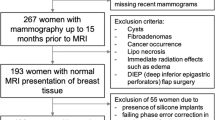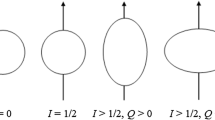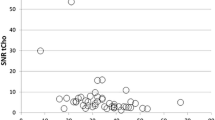Abstract
Background
The hypothesis that physiological and biochemical changes associated with proliferating malignant tumors may cause an increase in total tissue sodium concentration (TSC) was tested with non-invasive, quantitative sodium (23Na) magnetic resonance imaging (MRI) in patients with benign and malignant breast tumors.
Methods
23Na and 1H MRI of the breast was performed on 22 women with suspicious breast lesions (≥1 cm) at 1.5 Tesla. A commercial proton (1H) phased array breast coil and custom solenoidal 23Na coil were used to acquire 1H and 23Na images during the same MRI examination. Quantitative 3-dimensional 23Na projection imaging was implemented with negligible signal loss from MRI relaxation, or from radio-frequency field inhomogeneity, in less than 15 min. Co-registered 1H and 23Na images permitted quantification of TSC in normal and suspicious tissues on the basis of 1H MRI contrast enhancement and anatomy, with histology confirmed by biopsy.
Results
Sodium concentrations were consistently elevated in (N = 19) histologically proven malignant breast lesions by an average of 63% compared to glandular tissue. The increase in sodium concentration in malignant tissue was highly significant compared to unaffected glandular tissue (P < 0.0001, paired t-test), adipose tissue, and TSC in three patients with benign lesions.
Conclusion
Elevated TSC in breast lesions measured by non-invasive 23Na MRI appears to be a cellular-level indicator associated with malignancy. This method may have potential to improve the specificity of breast MRI with only a modest increase in scan time per patient.






Similar content being viewed by others
Notes
ACR BI-RADS Breast Imaging Reporting and Data System, American College of Radiology.
Assuming TSC = (1−EVF)·[Na]in + EVF·[Na]ex with EVF = 1−IVF.
References
Schnall MD, Blume J, Bluemke DA, DeAngelis GA, DeBruhl N, Harms S et al (2006) Diagnostic architectural and dynamic features at breast MR imaging: multicenter study. Radiology 238(1):42–53
Bluemke DA, Gatsonis CA, Chen MH, DeAngelis GA, DeBruhl N, Harms S et al (2004) Magnetic resonance imaging of the breast prior to biopsy. JAMA 292(22):2735–2742
Lee CH (2004) Problem solving MR imaging of the breast. Radiol Clin North Am 42(5):919–934, vii
Kuhl CK (2000) MRI of breast tumors. Eur Radiol 10(1):46–58
Rankin SC (2000) MRI of the breast. Br J Radiol 73(872):806–818
Jacobs MA, Barker PB, Bottomley PA, Bhujwalla Z, Bluemke DA (2004) Proton magnetic resonance spectroscopic imaging of human breast cancer: a preliminary study. J Magn Reson Imaging 19(1):68–75
Jacobs MA, Barker PB, Argani P, Ouwerkerk R, Bhujwalla ZM, Bluemke DA (2005) Combined dynamic contrast enhanced breast MR and proton spectroscopic imaging: a feasibility study. J Magn Reson Imaging 21(1):23–28
Stanwell P, Gluch L, Clark D, Tomanek B, Baker L, Giuffre B et al (2005) Specificity of choline metabolites for in vivo diagnosis of breast cancer using 1H MRS at 1.5 T. Eur Radiol 15(5):1037–1043
Katz-Brull R, Lavin PT, Lenkinski RE (2002) Clinical utility of proton magnetic resonance spectroscopy in characterizing breast lesions. J Natl Cancer Inst 94(16):1197–1203
Kim RJ, Lima JAC, Chen EL, Reeder SB, Klock FJ, Zerhouni EA et al (1997) Fast Na-23 magnetic resonance imaging of acute reperfused myocardial infarction—Potential to assess myocardial viability. Circulation 95(7):1877–1885
Ouwerkerk R, Bleich KB, Gillen JS, Pomper MG, Bottomley PA (2003) Tissue sodium concentration in human brain tumors as measured with 23Na MR Imaging. Radiology 227:529–537
Nissen H, Jacobsen JP, Horder M (1990) A review of 23Na nuclear magnetic resonance spectroscopy for the in vitro study of cellular sodium metabolism. Scand J Clin Lab Invest 50(5):497–507
Ouwerkerk R, Vanechteld CJA, Staal GEJ, Rijksen G (1989) Erythrocyte Na+/K+ ATPase activity measured with Na-23 NMR. Magn Res Med 12(2):164–171
Fraser SP, Diss JK, Chioni AM, Mycielska ME, Pan H, Yamaci RF et al (2005) Voltage-gated sodium channel expression and potentiation of human breast cancer metastasis. Clin Cancer Res 11(15):5381–5389
Leach MO (2001) Application of magnetic resonance imaging to angiogenesis in breast cancer. Breast Cancer Res 3(1):22–7
Reshkin SJ, Bellizzi A, Albarani V, Guerra L, Tommasino M, Paradiso A et al (2000) Phosphoinositide 3-kinase is involved in the tumor-specific activation of human breast cancer cell Na(+)/H(+) exchange, motility, and invasion induced by serum deprivation. J Biol Chem 275(8):5361–5369
Bhujwalla ZM, Artemov D, Natarajan K, Ackerstaff E, Solaiyappan M (2001) Vascular differences detected by MRI for metastatic versus nonmetastatic breast and prostate cancer xenografts. Neoplasia 3(2):143–153
Lagarde AE, Pouyssegur JM (1986) The Na+:H+ antiport in cancer. Cancer Biochem Biophys 9(1):1–14
Cameron IL, Smith NKR, Pool TB, Sparks RL (1980) Intracellular concentration of sodium and other elements as related to mitogenesis and oncogenesis in vivo. Cancer Res 40(5):1493–1500
Ignelzi RJ (1983) An analysis of the nuclear sodium content of human normal glia as well as tumors of glial and nonglial origin. Neurol Res 5(2):79–84
Pieri C, Giuli C, Bertoni-Freddari C (1983) X-ray microanalysis of monovalent electrolyte contents of quiescent, proliferating as well as tumor rat hepatocytes. Carcinogenesis 4(12):1577–1581
Reshkin SJ, Bellizzi A, Caldeira S, Albarani V, Malanchi I, Poignee M et al (2000) Na+/H+ exchanger-dependent intracellular alkalinization is an early event in malignant transformation and plays an essential role in the development of subsequent transformation-associated phenotypes. Faseb J 14(14):2185–2197
Kometiani P, Liu L, Askari A (2005) Digitalis-induced signaling by Na+/K+-ATPase in human breast cancer cells. Mol Pharmacol 67(3):929–936
Ng KH, Bradley DA, Looi LM (1997) Elevated trace element concentrations in malignant breast tissues. Br J Radiol 70(832):375–382
Ouwerkerk R, Jacobs MA, Bottomley PA, Fajardo LL (2002) A method for quantifying tissue sodium in breast tumors with short echo time 23Na MRI and co-registered proton images. In: Proceedings of the tenth meeting of the international society of magnetic resonance in medicine, Honolulu, HI, p 2061
Jacobs MA, Ouwerkerk R, Wolff AC, Stearns V, Bottomley PA, Bluemke DA et al (2004) Monitoring primary systemic therapy in locally advanced breast cancer using proton and sodium magnetic resonance imaging. In: Proceedings of the twelfth meeting of the international society of magnetic resonance in medicine, Kyoto, Japan, p 246
Boada FE, Gillen JS, Shen GX, Chang SY, Thulborn KR (1997) Fast three dimensional sodium imaging. Magn Reson Med 37(5):706–715
Ouwerkerk R, Weiss RG, Bottomley PA (2005) Measuring human cardiac tissue sodium concentrations using surface coils, adiabatic excitation, and twisted projection imaging with minimal T2 losses. J Magn Reson Imaging 21(5):546–555
Schomberg H, Timmer J (1995) The gridding method for image-reconstruction by Fourier transformation. IEEE Trans Med Imaging 14(3):596–607
Perneger TV (1998) What’s wrong with Bonferroni adjustments. BMJ 316(7139):1236–1238
Lidofsky SD, Xie MH, Sostman A, Scharschmidt BF, Fitz JG (1993) Vasopressin increases cytosolic sodium concentration in hepatocytes and activates calcium influx through cation-selective channels. J Biol Chem 268(20):14632–14636
Deluise M, Flier JS (1986) Functionally abnormal Na+-K+ pump in erythrocytes of a morbidly obese patient. J Clin Invest 69(1):38–44
Chatton JY, Shimamoto K, Magistretti PJ (2001) Effects of glial glutamate transporter inhibitors on intracellular Na+ in mouse astrocytes. Brain Res 893(1–2):46–52
Olson BR, Forman MR, Lanza E, McAdam PA, Beecher G, Kimzey LM et al (1996) Relation between sodium balance and menstrual cycle symptoms in normal women. Ann Intern Med 125(7):564–567
Hutson SW, Cowen PN, Bird CC (1985) Morphometric studies of age related changes in normal human breast and their significance for evolution of mammary cancer. J Clin Pathol 38(3):281–287
Brix G, Kiessling F, Lucht R, Darai S, Wasser K, Delorme S et al (2004) Microcirculation and microvasculature in breast tumors: pharmacokinetic analysis of dynamic MR image series. Magn Reson Med 52(2):420–429
Wellings SR, Jensen HM, Marcum RG (1975) An atlas of subgross pathology of the human breast with special reference to possible precancerous lesions. J Natl Cancer Inst 55(2):231–273
Squartini F, Bistocchi M, Buongiorno L (1981) Development, morphology, and progression of mammary tumors during and after fertile life in BALB/cfRIII mice. J Natl Cancer Inst 66(2):311–319
Jacobs MA, Ouwerkerk R, Wolff AC, Stearns V, Bottomley PA, Barker PB et al (2004) Multiparametric and multinuclear magnetic resonance imaging of human breast cancer: current applications. Technol Cancer Res Treat 3(6):543–550
Acknowledgments
This work was supported by NIH grants R21CA095907, 1R01CA100184, P50CA103175 ACS Grant IRS-58-005-40. The authors would like to thank Cynthia Schultz and Cynthia Maranto and Donna Hardy for their vital support in interactions with patients and in running MR protocols.
Author information
Authors and Affiliations
Corresponding author
Rights and permissions
About this article
Cite this article
Ouwerkerk, R., Jacobs, M.A., Macura, K.J. et al. Elevated tissue sodium concentration in malignant breast lesions detected with non-invasive 23Na MRI. Breast Cancer Res Treat 106, 151–160 (2007). https://doi.org/10.1007/s10549-006-9485-4
Received:
Accepted:
Published:
Issue Date:
DOI: https://doi.org/10.1007/s10549-006-9485-4




